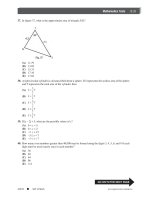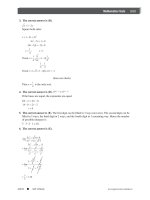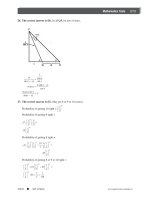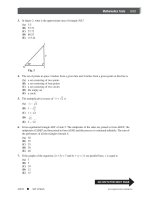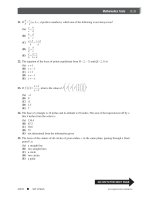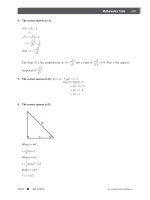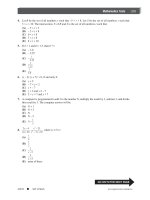SAT II Math Episode 2 Part 7 pps
Bạn đang xem bản rút gọn của tài liệu. Xem và tải ngay bản đầy đủ của tài liệu tại đây (694.61 KB, 20 trang )
Mathematics Tests 295
ARCO ■ SAT II Math www.petersons.com/arco
GO ON TO THE NEXT PAGE
3. The correct answer is (B).
Square both sides:
(does not check)
Thus x =
is the only root.
4. The correct answer is (D). 3
3(6 – r)
= 3
2(r – 1)
If the bases are equal, the exponents are equal.
5. The correct answer is (B). The first digit can be filled in 3 ways (not zero). The second digit can be
filled in 3 ways; the third digit in 2 ways, and the fourth digit in 1 remaining way. Hence the number
of possible intergers is
3 ⋅ 3 ⋅ 2 ⋅ 1 = 18.
6. The correct answer is (E).
Part VI296
www.petersons.com/arco ARCO ■ SAT II Math
7. The correct answer is (E).
8. The correct answer is (C).
9. The correct answer is (D). Let each root = r, then (x – r)
3
= x
3
– 3rx
2
+ 3r
2
x – r
3
10. The correct answer is (B). One real root is 2. By De Moivre’s Theorem, the complex roots are
separated by
Hence, in the second quadrant the root is 2(cos 144° + i sin 144°).
11. The correct answer is (C). x
2
– 3x – 10 < 0
(x – 5)(x + 2) < 0
then x – 5 > 0 and x + 2 > 0
x > 5 and x< – 2
Impossible
or x – 5 < 0 and x + 2 < 0
x < 5 and x > – 2
thus –2 < x < 5.
Mathematics Tests 297
ARCO ■ SAT II Math www.petersons.com/arco
GO ON TO THE NEXT PAGE
12. The correct answer is (E).
The length of
O
P
is .
The amplitude of
O
P
is 225° or radians.
Hence, the polar form is
.
13. The correct answer is (C). Since log
10
1 = 0 and the log N decreases as it approaches zero, it follows
that log
10
x < 0.
14. The correct answer is (D). The inverse of an implication is obtained by negating the hypothesis and
the conclusion. Thus the inverse of the given proposition is p → q.
15. The correct answer is (A).
16. The correct answer is (D). For f to be a function, there must be a unique value of y for any given
value of x. This is apparently true for all the sets above except where y ≥ x + 1; in this case, for any
given value of x, there is an infinity of values of y. Hence the nonfunction is (D).
17. The correct answer is (D). Eliminate fractions in both equations.
Part VI298
www.petersons.com/arco ARCO ■ SAT II Math
18. The correct answer is (A).
19. The correct answer is (A).
20. The correct answer is (B).
Mathematics Tests 299
ARCO ■ SAT II Math www.petersons.com/arco
GO ON TO THE NEXT PAGE
21. The correct answer is (C).
22. The correct answer is (D). The graph of y = tan x indicates that the function increases in all four
quadrants.
23. The correct answer is (B). Let the area of the section be A
Part VI300
www.petersons.com/arco ARCO ■ SAT II Math
24. The correct answer is (C).
Since sin x and cos x are positive, x is a first quadrant angle.
Method 1:
Method 2:
25. The correct answer is (B). From the following diagram, we see that we can get to P by (–5, 150º).
26. The correct answer is (D). ~ p means two heads do not show; therefore ~ p ^ q means three
heads show.
The probability of 3 heads is
.
27. The correct answer is (D).
28. The correct answer is (D). cos x (cos x – 2) = 0
cos x = 0, cos x = 2 (impossible)
x = 90º.
Mathematics Tests 301
ARCO ■ SAT II Math www.petersons.com/arco
GO ON TO THE NEXT PAGE
29. The correct answer is (C).
30. The correct answer is (C). The maximum value of the function is determined by the coefficient of
the function. Hence maximum value is 2m.
31. The correct answer is (A). Method 1:
or
Method 2:
32. The correct answer is (D).
or y = 2x
33. The correct answer is (A). Let
then
or
thus
However, the range of f(x) consists of all real numbers > 0 so that f
–1
(x) is defined for x > 0.
Part VI302
www.petersons.com/arco ARCO ■ SAT II Math
34. The correct answer is (B). By similar triangles.
35. The correct answer is (B). The x-intercepts, also called roots or zeros, are found by setting f(x) = 0
36. The correct answer is (B).
Multiply by e
x
: e
2x
+ e
x
– 1 = 0
By quadratic formula:
Since e
x
can only be a positive number, reject the minus sign in the formula.
Thus
only 1 root
Mathematics Tests 303
ARCO ■ SAT II Math www.petersons.com/arco
GO ON TO THE NEXT PAGE
37. The correct answer is (C). When x ≥ 0 and y ≥ 0,
the equation is x + y = 4.
When x ≤ 0 and y ≤ 0,
the equation is – x – y = 4.
When x ≤ 0 and y ≥ 0,
the equation is – x + y = 4.
When x ≥ 0 and y≤ 0,
the equation is x – y = 4.
The graph thus becomes the following:
The graph consists of the sides of a square.
38. The correct answer is (C). From the right triangle,
By equating areas, we get
Part VI304
www.petersons.com/arco ARCO ■ SAT II Math
39. The correct answer is (D). Let the original radius = 1
40. The correct answer is (E). The two numbers must both be even or both be odd. The probability of
choosing two even numbers is
: the same for two odd numbers, hence the probability of
one or the other is
.
41. The correct answer is (D).
Hence no value of x.
42. The correct answer is (C). Let the series be a, ar, ar
2
… ar
12
.
Mathematics Tests 305
ARCO ■ SAT II Math www.petersons.com/arco
GO ON TO THE NEXT PAGE
43. The correct answer is (E).
m
m
44. The correct answer is (C).
45. The correct answer is (C) At the y–intercept, x = 0
Part VI306
www.petersons.com/arco ARCO ■ SAT II Math
46. The correct answer is (E) The remainder is 5(–1)
2n+1
– 10(–1)
2n
+ 3(–1)
2n–1
+ 5.
Since 2n + 1 and 2n – 1 are odd and 2n is even, the remainder
= 5(–1) – 10(1) + 3(–1) + 5
= –5 – 10 – 3 + 5 = –13
47. The correct answer is (B) r
1
+ r
2
= p and r
1
r
2
= q
Then (r
1
+ r
2
)
2
= p
2
or r
1
2
+ r
2
2
+ 2r
1
r
2
= p
2
Thus r
1
2
+ r
2
2
= p
2
– 2q
48. The correct answer is (E)
49. The correct answer is (D).
50. The correct answer is (B). The maximum value for 3 – cos 2x is attained when cos 2x is at a mini-
mum value. Since the least value for the cosine of an angle is –1,
let cos 2x=–1
then 2x=π
Mathematics Tests 307
ARCO ■ SAT II Math www.petersons.com/arco
GO ON TO THE NEXT PAGE
PRACTICE TEST 3
Answer Sheet
Math Level IIC
Directions: For each question in the sample test, select the best of the answer choices and blacken
the corresponding space on this answer sheet.
Please note:
(a) You will need to use a calculator in order to answer some, though not all, of the questions in
this test. As you look at each question, you must decide whether or not you need a calculator
for the specific question. A four-function calculator is not sufficient; your calculator must be at
least a scientific calculator. Calculators that can display graphs and programmable calculators
are also permitted.
(b) Set your calculator to radian mode or degree mode depending on the requirements of the
question.
(c) All figures are accurately drawn and are intended to supply useful information for solving
the problems that they accompany. Figures are drawn to scale UNLESS it is specifically stated
that a figure is not drawn to scale. Unless otherwise indicated, all figures lie in a plane.
(d) The domain of any function f is assumed to be the set of all real numbers x for which f(x) is
a real number except when this is specified not to be the case.
(e) Use the reference data below as needed.
Part VI308
www.petersons.com/arco ARCO ■ SAT II Math
REFERENCE DATA
SOLID VOLUME OTHER
Right circular cone L = cl V = volume L = lateral area
r = radius c = circumference of base
h = height l = slant height
Sphere
S = 4πr
2
V = volume
r = radius
S = surface area
Pyramid
V = volume
B = area of base
h = height
PRACTICE TEST 3
MATH LEVEL IIC
50 Questions • Time—60 Minutes
1. If x and y are real numbers, which one of the following relations is a function of x?
(A) {(x, y) | x = y
2
–1}
(B) {(x, y) | y = x
2
+ 1}
(C)
(D) {(x, y)| y < x – 2}
(E) x = sin y
2. If P represents the set of rhombi and Q the set of rectangles, then the set P ∩ Q represents the set of
(A) squares
(B) trapezoids
(C) parallelograms
(D) quadrilaterals
(E) rectangles
3. The length of the vector that could correctly be used to represent in the complex plane the number
is
(A) 11
(B)
(C)
(D)
(E)
Mathematics Tests 309
ARCO ■ SAT II Math www.petersons.com/arco
GO ON TO THE NEXT PAGE
4. If log
8
p = 2.5 and log
2
q = 5, p expressed in terms of q is
(A) p = q
2
(B) p = q
8
(C) p = q
3/2
(D) p = q
5/2
(E) p = q
3
5. If circle R, of area 4 square inches, passes through the center of and is tangent to circle S, then the area
of circle S, in square inches, is
(A) 8
(B)
(C)
(D) 12
(E) 16
6. In a cube, the ratio of the longest diagonal to a diagonal of a base is
(A)
(B)
(C)
(D)
(E) 2:1
7. Which ordered number pair represents the center of the circle x
2
+ y
2
– 6x + 4y – 12 = 0?
(A) (9,4)
(B) (–3,2)
(C) (3,–2)
(D) (–6,4)
(E) (6,4)
8. sin (135° + x) + sin (135° – x) equals
(A)
(B) –1
(C)
(D)
(E)
9. If 3
7
= 7
x
, what is the approximate value of x?
(A) .95
(B) 1.95
(C) 2.95
(D) 3.95
(E) 4.15
Part VI310
www.petersons.com/arco ARCO ■ SAT II Math
10. In a circle a central angle of 60º intercepts an arc of 15 inches. How many inches is the radius of the circle?
(A)
(B)
(C) 4
(D)
(E) not computable from given data
11. For what value of x is the function sin x cos x a maximum?
(A) 2π
(B)
(C)
(D)
(E)
12. Four men line up in a row. What is the probability that a certain two are next to each other?
(A)
(B)
(C)
(D)
(E)
13. Approximately, what is ?
(A) 2.32
(B) 2.43
(C) 2.54
(D) 2.65
(E) 2.76
14. If P implies Q, an equivalent statement is
(A) Q implies P
(B) Q is a necessary condition for P
(C) P is a necessary condition for Q
(D) Not P implies Q
(E) Not P implies not Q
Mathematics Tests 311
ARCO ■ SAT II Math www.petersons.com/arco
GO ON TO THE NEXT PAGE
15. T varies directly as the square of r and inversely as the cube of s. If r is tripled and s is doubled, the
value of T is
(A) multiplied by 3/2
(B) multiplied by 6
(C) multiplied by 9/8
(D) multiplied by 2
(E) divided by 2
16. If log x ≥ log 2 +
1
2
log x, then
(A) x ≥ 2
(B) x ≤ 2
(C) x ≤ 4
(D) x ≥ 4
(E) x ≥ 1
17. 2 cos
3
A sin A + 2 sin
3
A cos A equals which one of the following?
(A) cos 2A
(B) 2 sin A
(C) 2 cos A
(D) cos
2
A
(E) sin 2A
18. An isosceles triangle with base 24 and legs of 15 is inscribed in a circle. Find the radius.
(A) 7
(B)
(C) 25
(D)
(E) cannot be determined
19. Two roots of 4x
3
+ 8x
2
+ Kx – 18 = 0 are equal numerically but opposite in sign. Find the value of K.
(A) –2
(B) +2
(C) –9
(D) +9
(E)
20. If log
10
x = y and
, then
(A)
(B)
(C)
(D)
(E) none of these
Part VI312
www.petersons.com/arco ARCO ■ SAT II Math
21. Find the angle between π and 2π that satisfies the equation: 2 sin
2
x + 5 cos x + 1 = 0
(A)
(B)
(C)
(D)
(E)
22. Two heavenly bodies are respectively 8.9 × 10
8
miles and 2.7 × 10
7
miles distant from the earth.
Approximately how much farther way from the earth is the first than the second?
(A) 6.2 × 10
7
(B) 8.6 × 10
7
(C) 8.6 × 10
8
(D) 86 × 10
6
(E) 62 × 10
8
23. Find the product of an infinite number of terms:
3
1/2
× 3
1/4
× 3
1/8
× 3
1/16
× …
(A) 3
1/2
(B)
(C) 3
2
(D) 3
(E) 1
24. Which of the following is an (x,y) coordinate pair located on the ellipse 4x
2
+ 9y
2
= 100?
(A) (1, 3.5)
(B) (1.4, 3.2)
(C) (1.9, 2.9)
(D) (2.3, 3.1)
(E) (2.7, 2.6)
25. If log
4
44 = x, what is the approximate value of x?
(A) 2.73
(B) 2.70
(C) 1.67
(D) 1.64
(E) 1.61
26. A boy walks diagonally across a square lot. What percent does he save by not walking along the edges
(approximately)?
(A) 22
(B) 29
(C) 33
(D) 20
(E) 24
Mathematics Tests 313
ARCO ■ SAT II Math www.petersons.com/arco
GO ON TO THE NEXT PAGE
27. What is the largest rod that can just fit into a box 24″ × 8″ × 6″ (in inches)?
(A) 24
(B) 25
(C) 26
(D) 28
(E) 30
28. Find the solution set of the inequality x
2
– x – 6 < 0.
(A) x > –2
(B) –2 < x < 3
(C) x > 3 and x < –2
(D) x > 3 or x < –2
(E) x < 3
29. If f(x) = x
2
+ 2 and , write the expression g[f(x)] in terms of x.
(A)
(B)
(C)
(D)
(E) none of these
30. Find the value of K if (x + 1) is a factor of x
8
+ Kx
3
– 2x + 1.
(A) 1
(B) 2
(C) 3
(D) 4
(E) 5
31. The portion of the plane, whose equation is
8x + 20y + 15z = 120,
that lies in the first octant forms a pyramid with the coordinate planes. Find its volume.
(A) 90
(B) 120
(C) 140
(D) 150
(E) 160
Part VI314
www.petersons.com/arco ARCO ■ SAT II Math
32. Write in the form a + bi.
(A)
(B)
(C)
(D)
(E)
33. Let the symbol ∆ be defined as
a ∆ b = sin a sin b – cos a cos b. What is the approximate value of 17° ∆ 33°?
(A) .766
(B) .643
(C) .125
(D) 0
(E) –.643
34. What is the equation of the perpendicular bisector of the line segment whose end points are (2, 6) and (–4, 3)?
(A) 4x + 2y – 5 = 0
(B) 4x – 2y + 13 = 0
(C) x – 2y + 10 = 0
(D) x + 2y – 8 = 0
(E) 4x + 2y – 13 = 0
35. Of the following, the one which is a cube root of i is
(A) +i
(B) cos 30° + i sin 30°
(C) cos 90° + i sin 90°
(D) cos 120° + i sin 120°
(E) cos 60° + i sin 60°
36. What is the period of the curve whose equation is
?
(A) 60°
(B) 120°
(C) 180°
(D) 360°
(E) 720º

